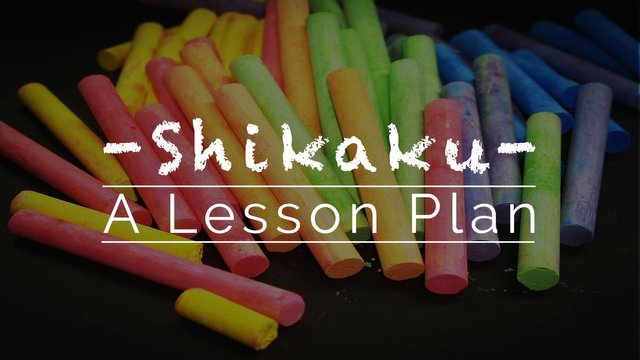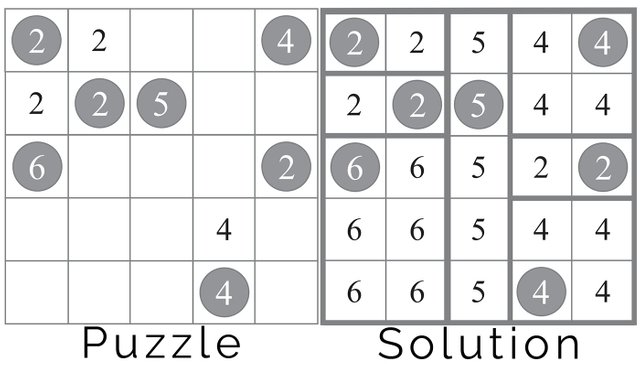A Lesson Plan using Shikaku Puzzles

Some Introduction
We were in the last week of Term 2, it was Wednesday, and my Year 7 Maths students were adding the final touches to their last assessment before the holidays. The second to last Maths lesson for the term was wrapping up, and I realised that we still had one more to go. Friday, the lesson directly before lunch. Awesome! Twenty-six Year 7's, all eagerly waiting for that final bell before being released to enjoy three weeks of freedom. The lesson(s) directly before lunch can sometimes be tedious with middle-schoolers, but the lesson(s) directly before lunch on the last day of term with middle-schoolers can often be a whole new ball game.
Don't get me wrong. This group of students are fantastic. They are well-behaved and have slowly been increasing their work ethic as the year has progressed. It's just that when you're 12 or 13, you tend to still get excited about things, and the holidays are no exception!
I'm a big believer that whatever you do in the classroom, must be authentic. Lessons really need to have real-world applications (despite how difficult this can sometimes be to convince the students of - 'how will I ever use linear graphs when I leave school?'!), otherwise, it is easy to lose even the most dedicated of students. This is why, even for a stand alone lesson, one where you are just enjoying something more relaxed that the formalities of using the textbook questions, I still like to have ties to the curriculum. It might not directly relate to the current unit we are doing, or have just done, but I like to try and keep it within the parameters of a unit that will, or has, been studied during the year.
And so, this is where I found myself. One lesson to go. All assessment completed. Reports already sent home. How to find a lesson that the students would enjoy, learn from and not think a complete waste of time. I'll tell you, I went through the list of go to lesson plans for when you just need something, but struggled to come up with something that I thought would add value for their final few hours of the term.
Thursday morning I was sitting in the staffroom, reading the newspaper, when a colleague approached and began telling me of a seminar she had been to earlier in the week. The seminar had featured a well known Maths teacher from New South Wales who used part of his time to workshop a few Mathematical game-type activities that teachers could use with students, and she happened to think that they might have been of use in Year 7 Maths, so she gave me the information and pretty much just left me with it. Well, I can tell you, I ran with it.
I looked at the three different ideas that she had been presented with, and found that of the three, the one that seemed most relevant, in as much as it would offer a 'teaching' angle as well as a fun activity, was Shikaku. Now, if you're like my, you might instantly think, 'Oh, Sudoku. I know that!', well, you would be (and I'm sorry to say) incorrect. Shikaku is not Sudoku. It would be fair to say, that it is actually nothing like Sudoku at all!
Shikaku is a square grid with some numbers on it. The aim of the game is to successfully divide the grid into smaller sections based upon the numbers. The numbers represent how many consecutive grid squares you should include within that selection. For example, if you have a grid square with 2 in it, then you draw around that square and one other consecutive square, creating a 'selection' of two squares. If a square has 4 in it, then you draw around that square and three consecutive squares, and so on. You can see how this works in the image below.

This image is fairly self-explanatory, as you can see, on the left is the incomplete puzzle, and on the right is the completed one. This example is a relatively easy one. They can get quite complex, but it's fair to say that the students really enjoyed them, and became quite engaged once they had really got the hang of them.
By now, you might be wondering: 'Where's the learning in this? You said earlier that you didn't like to give an activity if it didn't have some sort of real-world application. You said that you believed that authenticity is important, and tha...!' Yes, I did say that, and Shikaku is underpinned by the use of and understanding of square numbers. You can see in the example above, that both of the 4's are encapsulated to form a square, and that is the crux of a square number. To quote the Year 7 textbook:
If a number can be represented by a square arrangement of dots, it is called a square number or perfect square.
Shikaku puzzles can be solved much easier if students find the perfect squares and draw the boxes around these numbers first, ensuring that they are creating a square, and not some other shape around these. Such as the two 4's above. Once that have done this, the other numbers fall into place quite (but not always - remember, these puzzles are designed to be challenging!) easily.
The 'Rules' of the Game

While completing some of these puzzles would be fun in itself, I decided to create somewhat of a game around the use of these as well. Being their last Maths lesson for the term, I wanted my students to enjoy themselves as well as learn something small. We had already looked at square numbers in Term 1, so this was going to form more of a refresher than anything else.
What You Will Need
- A puzzle 'pack' for each student. I gave my students (total of 5 sheets of paper):
- an example like the one above;
- 2 of the 5x5 puzzles (printed on one A4 piece of paper);
- 2 of the 8x8 puzzles (printed on one A4 piece of paper);
- 2 of the 10x10 puzzles (printed on one A4 piece of paper), and
- 1 of the 10x15 puzzles (printed on one A4 piece of paper).
- Answer sheets for the selected puzzles for yourself.
- Some rewards - I used some individually wrapped fruit chew lollies, but something like Minties or Fantales would suffice.
The Rules
I made these up to fit my circumstances, but you could adapt and change them as needed.
- Prizes are awarded for the following (this means that students could potentially win a total of 8 prizes during the lesson (4 for completing puzzles, and 4 for good colouring):
- Completing both puzzles on a sheet correctly, and
- Colouring both puzzles on the sheet in a creative manner.
- Students could only bring one sheet to the front for marking at a time.
- If they wanted the bonus 'colouring' prize, than they had to do this before coming to the teacher for marking the page.
Students wouldn't receive a prize if they had done the following:
- Created shapes on the puzzle other than squares or rectangles - no 'L' shapes were allowed.
- They hadn't coloured neatly - I was quite meticulous in this.
- The hadn't completed both puzzles on the sheet.
- They tried to get me to mark more than one page at a time
I was quite brutal, in some instances, when it came to marking and assigning prize, but, hey, when there are lollies up for grabs, they can be precise and follow the rules!
A Simple (Very Simple) Lesson Plan
If this interests you, and you would like to give it a go, I followed a fairly simple lesson plan. I managed to cram this into 50 minutes, but it would probably work better in a 90 minute double lesson. Most students didn't;t get through all of the puzzles I gave them because there were simply too many (most opted to get the bonus prizes for colouring as well!) and also because we stopped about ten minutes before the end of the lesson so I could explain about the concept of completing the square numbers first.
- Introduce the concept of Shikaku and explain what they are. I did this as I distributed the handout (puzzle pack).
- Run through the example sheet (as the image above) so that students understand how to complete the puzzles. Allude to the idea that there is a Mathematical process they can use to complete these easier, but don't tell them immediately. (I purposely didn't tell then to find and complete the square numbers first.)
- Explain the rules - I didn't write these on the board, but in future lessons, I would do this. I think it will help clarify for students exactly how they can win prizes.
- Take questions - there were only a few - mainly on how to win prizes!!
- Students complete puzzles - obviously, the bulk of class time.
- **Optional - I chose to stop them with about 10 minutes remaining to remind tham of our lessons earlier in the year on square numbers, and to tell them how finding the square numbers in a Shikaku puzzle first, will help them to solve it easier.
- Wrap up.
Conclusion
I hope that this post has provided you with some inspiration, or at the very least, something that you can use in a practical sense. For me, this was one of those lessons where you walk away feeling good about teaching. They were all engaged, and they were all taught something small about Maths, while having fun too. A successful lesson.
If you do decide to use plan, or tailor it to you classroom, I would love to hear about it, so please drop a comment in the comments section outlining your experience with this. If you would like to use it, but something here is unclear, also, please drop a comment below, and I'll try to clear up any grey areas as quickly as possible.
All images were created by myself, or used from Pexels.

Join us @steemitbloggers
Animation By @zord189

👍
This is pretty cool, although I still don't really get the game. I don't get Sudoku either mind you.
Ha! It's one of those games that once you've done a couple, you sort of get that 'Aha!' moment and then it's all downhill from there. Probably a little easier than Sudoku.
I won't lie; I am with @choogirl lol :) but I think this is pretty cool and a great way to teach & learn. Thank you for expanding my mind @steveblucher <333 Much Love!
This comment was made from https://ulogs.org
I wrote a post learning sudoku without numbers which took weeks to pull together and made 2 cents, 2 years ago :)
Google sudoku without numbers and I'm on the first page of results. Pretty happy with that though.
I feel like you'd be higher up if you looked like this guy

That's up to coinmarketcap.com.
Could only be a week away.
love this idea! I'm a big fan of sudoku as well. a question: do all the numbers have to be in a neat shape (column/row or square) or can you get some of those funky tetris shapes going on and still be valid, so long as they are connected?
I think that they're supposed to be columns, rows or squares. I was pretty strict on it because I was offering prises for completing them, and didn't want to make it too easy, but you could probably be more flexible. I found that if the 'square numbers' were completed first, then mostly columns or rows fit the rest.
This is very cool. I have never heard of it even though I played sudoku when it was all the rage a few years ago. Seems like a good tool for teaching. I suspect that this would fit in with the home-school Math-U-See material, which is my current favorite content for teaching math--way better than what our local schools are doing.
Proud member of #steemitbloggers @steemitbloggers
Thanks @toddrjohnson. It was actually really well received by the students, and the kicker for me is that they actually learn something. I'm going to check out Math-U-See and find if there are any overlaps with what we teach. The good thing I'm finding with Maths, is that it's pretty much universal in teaching basic concepts.
The quality of the Math U See material and method is really hard to see from their website. We started buying it years ago based on recommendations in home school groups. While our kids go to public school, we have to supplement at home, because the public schools are forced to fly through material, instead of using mastery learning. Math U See's videos are really low tech (an old guy at a whiteboard), but his content and use of manipulatives (which you also buy) is brilliant. I've had graduate-level math, yet I've learned things from his videos that I didn't know--mostly ways to think about basic math concepts.
As much as I hate to say it, you don't always need the bells and whistles that technology bring to a classroom to teach something well. Often technology can become counter-productive, in as much as it can dazzle the students, removing their concentration from the object of the lesson.
Unfortunately, I think you'll find that most schools now, public and private alike, move through material at a very fast pace, especially at the earlier years. It's a shame, because this it the time we should be building strong foundations, but it seems the governments believe that our future generations only need a foundation of sorts.
Congratulations! Your post has been selected as a daily Steemit truffle! It is listed on rank 14 of all contributions awarded today. You can find the TOP DAILY TRUFFLE PICKS HERE.
I upvoted your contribution because to my mind your post is at least 11 SBD worth and should receive 139 votes. It's now up to the lovely Steemit community to make this come true.
I am
TrufflePig, an Artificial Intelligence Bot that helps minnows and content curators using Machine Learning. If you are curious how I select content, you can find an explanation here!Have a nice day and sincerely yours,

TrufflePigNever quite able to understand this game. It is fascinating to use this method though.
I'd never heard of it until a month ago either. Quite a good game though, and the students really seemed to enjoy it. Because of their age, the colouring aspect just added an extra layer of fun for them!
That's really interesting!
Congratulations! This post has been upvoted from the communal account, @minnowsupport, by steveblucher from the Minnow Support Project. It's a witness project run by aggroed, ausbitbank, teamsteem, someguy123, neoxian, followbtcnews, and netuoso. The goal is to help Steemit grow by supporting Minnows. Please find us at the Peace, Abundance, and Liberty Network (PALnet) Discord Channel. It's a completely public and open space to all members of the Steemit community who voluntarily choose to be there.
If you would like to delegate to the Minnow Support Project you can do so by clicking on the following links: 50SP, 100SP, 250SP, 500SP, 1000SP, 5000SP.
Be sure to leave at least 50SP undelegated on your account.
This is really clever. I should try this with my boys too. My eldest is 13 so I can understand what you go through with your students.
I’m going to google more of such puzzles & try it with my boys. Thanks for the sharing.
Thanks, @ireenchew. I hope that your boys get a great deal of enjoyment out of it. If you need any clarification on anything, feel free to ask.
Congratulations @steveblucher! You have completed the following achievement on Steemit and have been rewarded with new badge(s) :
Click on the badge to view your Board of Honor.
If you no longer want to receive notifications, reply to this comment with the word
STOPI've never heard of Shikaku, but this does sound like a wothwhile activity! Kudos to you for keeping their final class interesting! Thanks for sharing this with #steemitbloggers 😊